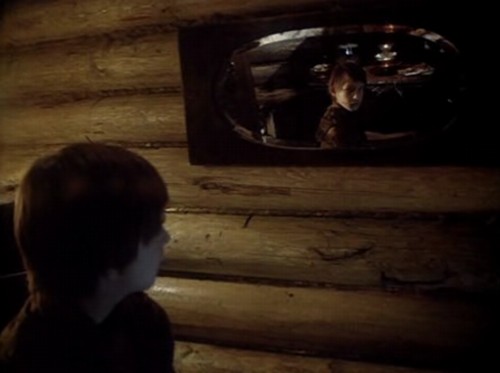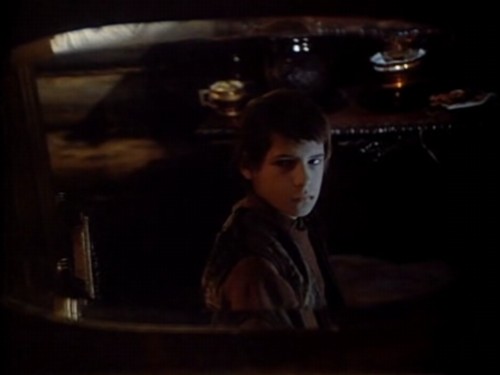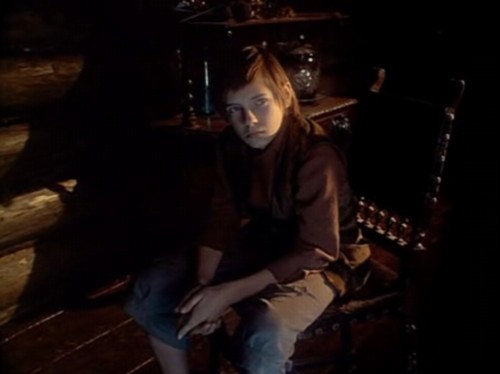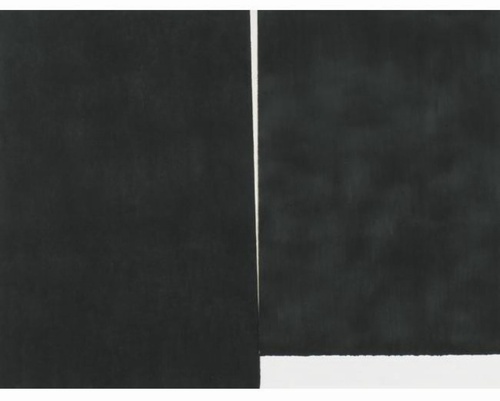
Richard Serra, The American Flag is not an object of worship, 1989, 288 x 376 cm
One of the artworks ImClone CEO Sam Waksal bought from Gagosian but didn’t pay sales tax on in 2000 was a huge, $350,000 Richard Serra drawing titled, The American Flag is not an object of worship.
Interestingly, when the drawing sold at Sotheby’s in 2004 [for $232,000 against an estimate of just $80-120,000. There really ought to be a word for a deal where you weasel out an 8.25% “discount” after dumbly overpaying by 50-300%. Maybe a Waksale.], the provenance only mentioned collector/Dia board member/Kim Heirston dater Dr. Pentti Kouri [who passed away in 2009] and the Leo Castelli Gallery, where the work was originally shown.
And what a show it was.
“8 Drawings: Weights and Measures” opened in September 1989, in the wake of the Tilted Arc controversy, and six months after the 1981 sculpture was removed [and according to the artist, “destroyed”] from Federal Plaza in lower Manhattan. And from the titles Serra gave the massive paintstick on paper works, I don’t think he’d quite gotten over the loss.
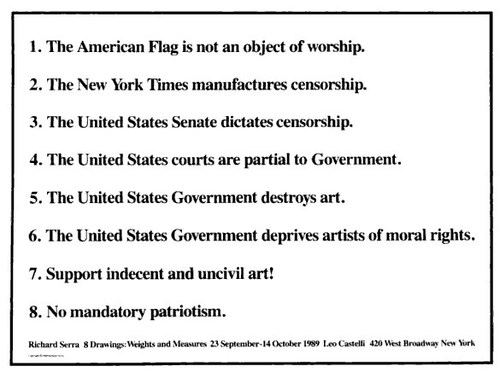
Poster/flyer for “Richard Serra 8 Drawings: Weights and Measures”
There’s a room in the Met’s Serra drawings retrospective with several works from the Castelli “Weights and Measures” show, including The United States Courts are partial to the Government [105×185 in.], No mandatory patriotism [93×201 in.], and the massive The United States Government destroys art [113×215 in.], which is owned by the Broads.
I can’t find out online, and I don’t have my Serra drawings catalogue raisonné with me to check, but it would be interesting, if maybe a little too neatly literal, if the cumulative dimensions of the eight “Weights and Measures” drawings added up to 120 feet, the length of Titled Arc. It’d turn the drawings into fragmented shadows of the lost sculpture, ghost slabs floating in a gallery before being dispersed to haunt collections around the world. Serra’s not averse to coding such biographical or historical references in a work’s dimensions; I seem to remember hearing that the dimensions of the six forged steel blocks in his 1996 sculpture 58 x 64 x 70 were derived from his and his wife Clara’s eye heights. [I can’t find any mention of that now, though; I’ll have to check.] Anyway, TBD all over the place.
[UPDATE: thanks to the Communications office at the Met for sending along the checklist, which also includes the dimensions of the other two W&M drawings in the show. The four drawings mentioned here do, in fact, add up to 62 linear feet. So a 120 ft total is in the realm of the possible.]
2015 UPDATE: yes, but maybe not? I can’t believe I never published the result of this research, but I did gather the dimensions of all the W&M drawings, and they ran about 117 linear feet. If they each have 4.5-in larger framed dimensions, they’ll add up to 120 feet, but I doubt Serra’s numerological interests would incorporate frames. I’d love to be wrong about that and right about the dispersed, destroyed ghost of Tilted Arc, but I think it’s the other way around. Oh well.
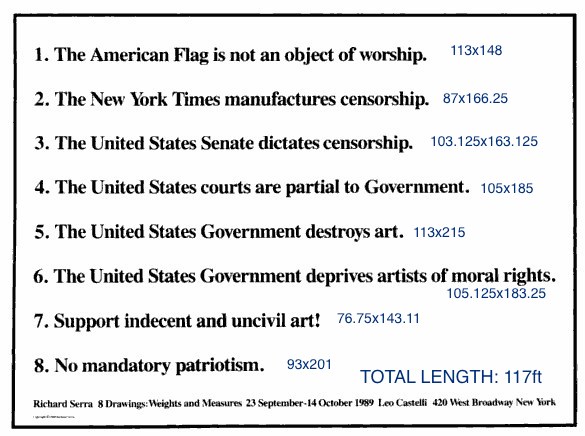
Weights & Measures, annotated, dimensions in inches
Author: greg
On Looking Into Tarkovsky’s Mirror
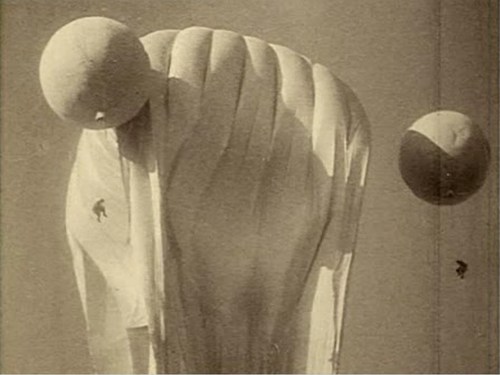
I just watched Tarkovsky’s 1975 film The Mirror for the first time as an adult, basically; when I saw it in college, I had no clue and was bored out of my gourd by it. In fact, for a long time, I’d conflated it, burning houses and whatnot, with The Sacrifice.

Anyway, the largely plotless, highly autobiographical film is a memory-like collage of documentary footage and vignettes set in disparate time periods. When I say, plotless, though, I mean it’s a movie about a guy who spent ten years trying to make a movie about his childhood purely as an excuse to show the awesome scenes of a Soviet military balloon from the Spanish Civil War. At least that’s how it looks to me now.
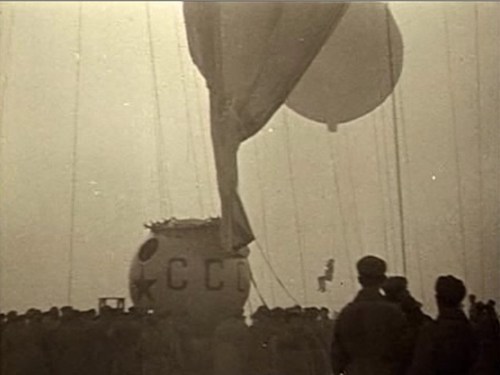
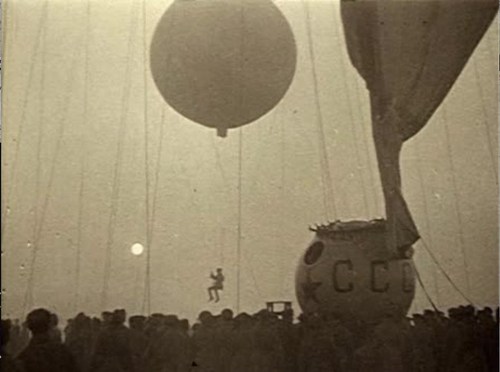
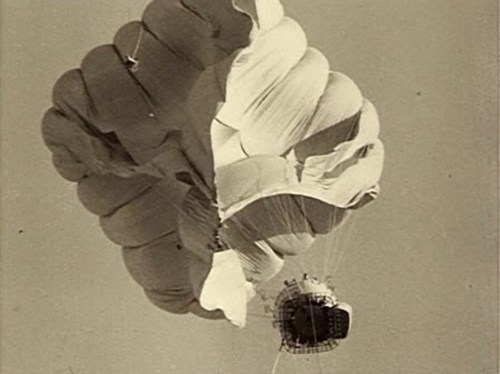
Previously: an image of a guy on a balloon inspecting Echo II at Lakehurst, NJ
From The Department Of Corrections: Side-Stepping
You never know what you’ll find digging around in archives, even your own. While looking back at greg.org posts about Alexander Payne and Dany Wolf, I bumped into this gem from 2003, the reconstructed list of artworks Sam Waksal bought from Gagosian Gallery without paying NY state sales tax, and how much he paid.
At the time, I’d written that not only had Waksal, the CEO of ImClone whose case broke around the same time his friend Martha Stewart was getting charged with insider trading, the newbie collector hadn’t negotiated a discount from the gallery beyond the sales tax. And that the ploy of having empty boxes–or in some of Waksal’s purchases, just the invoices–sent out of state, had “been tripping up art world naifs since the 80’s, at least.”
Well, this statement was incorrect on several fronts. The investigation of Waksal had followed on the fraud investigation of certified art world naif Tyco CEO Dennis Koslowski, remember, which had been triggered by an art sales tax evasion inquiry involving the fictitious shipment of 3rd-rate Monets to a factory in New Hampshire. But in a subsequent 2004 wrap-up on the caper, the NY Times’ Timothy O’Brien reported that as many as 90 art world figures were implicaited in DA Robert Morgenthau’s investigation, including many non-naifs.
And as for the 80’s, well.
On a recent visit to the Leo Castelli Gallery collection at the Archives of American Art, I came across a letter from the gallery to Mr. Frederick Weisman, one of the biggest collectors around, who had apparently been confused by the arrival of an empty box at his Sunset Blvd office. The letter was dated Jun 22, 1965:
The package you received was intentionally empty. It represents a Lichtenstein banner that Richard purchased. The package was sent to your California address to side-step New York City tax. I hope this hasn’t caused you any unnecessary concern.
It’s not specified, but I’ll assume the banner was Pistol, 1964, the best of the three Lichtenstein made with the Betsy Ross Flag & Banner Co., Richard, of course, is the Richard Weisman of Find The Warhols! fame, who does in fact live in California. And so, it would seem, does the banner.
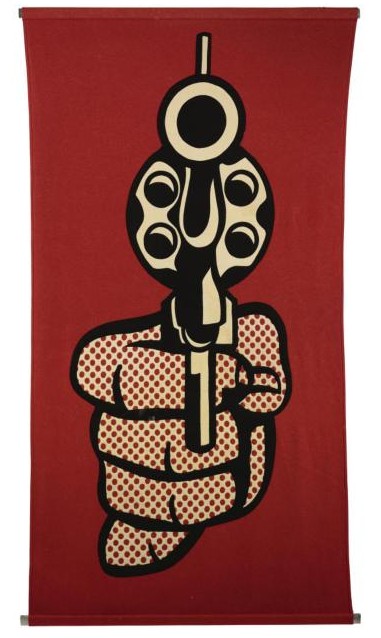
The history for a Pistol banner sold at Sotheby’s in 2008 mentions its inclusion in a 1967 exhibition at the Pasadena Museum, which Weisman’s uncle Norton Simon would soon take over.
It appears the only nair around here is 2003 me.
The Fall Of Bootleg (Empire)
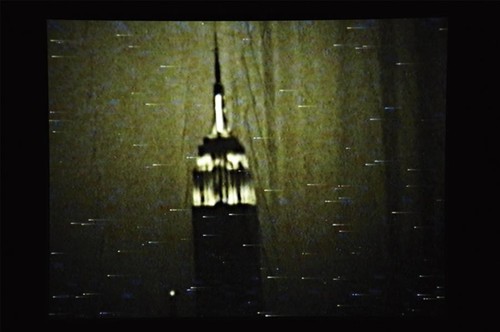
In 1997 Douglas Gordon surreptitiously videotaped two hours of Andy Warhol’s Empire during an installation in Berlin. He called it Bootleg (Empire):
‘I did a version of ‘Empire’, which was called ‘Bootleg Empire’, it is almost like the amateur version of the auteur masterpiece — it’s very shakily done. I lived in Berlin for a while and I went to see Warhol’s ‘Empire’ and I thought ‘I may never get to see this again’, so I filmed it for an hour went to the pub and then came back and filmed it for the last hour. So mine only lasts for two hours — so it’s like ‘the best of’ or something. But quite often my version is seen with his films in exhibitions, which is kind of funny as mine is slightly more dramatic as it is shaky and there are shadows of people walking in front of the camera.’ (Jean Wainwright ‘Mirror Images’ (Interview with Douglas Gordon) Art Monthly, Dec-Jan 2002/03, No. 262) [via a new path]
In 1998, he released Bootleg (Empire) as a video edition of eleven. For whatever reason, maybe because he has the word “bootleg” in the title, it’s often referred to as an homage. How many intellectual property battles could be dodged if everyone made sure to use that word, I wonder.
Anyway, one of the Bootleg (Empire) editions didn’t sell Friday at Philips de Pury. The estimate was $30-40,000.
And the details seem confusing. The lot description says “installation dimensions variable,” as you’d expect from a Gordon. But when another of the edition sold in 2000 at Christie’s [for $9,400], the description said it was “for view on monitor only.” The Christie’s edition also contained two tapes, a VHS and a Beta, but the duration is given as only 62 minutes, not two hours. Philips doesn’t bother to provide the duration information in their catalogue, but the piece was two hours long at the Guggenheim’s “Haunted” exhibition last fall.
So far, I can find mentions of at least three other Bootleg works, all of which predate Empire. Bootleg (Big Mouth, Cramped and Stoned), use slowed down, slient concert performance footage from the Smiths, the Cramps, and the Rolling Stones, respectively.
Wow, The Unseen Original Ending From Alexander Payne’s Election
Wow. It’s amazing how awkward and wrong this original ending to Alexander Payne’s 1999 feature Election seems. According to Peter Sciretta at Slashfilm, this six-minute segment comes from a VHS transfer of an original work print found at a flea market. The ending tested so badly, Payne went back to shoot additional footage for the more satisfyingly harsh ending he released.
Sciretta notes that there’s never been any discussion of another ending to the film, but hey-ho, It’s right there in Payne’s and Jim Taylor’s original script.
Watch The Never Before Seen Original Ending of Alexander Payne’s ‘Election’ [slashfilm via matthew clayfield]
Previously: I co-hosted a MoMA Film Dept. party for Alexander Payne in 2003. more recapping here.
Shh, Don’t Speak.
From Dennis Lim’s brief Q&A with Gus Van Sant at Cannes, where Restless is [finally?] debuting:
We did silent takes of almost every scene so we could maybe use them in the editing. Terry Malick apparently shoots silent takes so he can mold what he wants out of the scenes. But with our takes we actually created a silent version because we had enough material and we realized we could — maybe it’ll be on the DVD. Everything is there except the dialogue — all the sounds and music, and you hear all the footsteps, but there’s nobody talking and no lips moving. They’re the same scenes, but it has the distance of not being dialogue-driven. It’s the exact same love story but it plays like a different movie.
It’s funny, because Gerry and Elephant only have like 10 pages of dialogue between them anyway.
Previously: Gus Van Sant’s go-to guy, the greg.org 2003 interview with producer Dany Wolf
The Artist Presently Known As Man
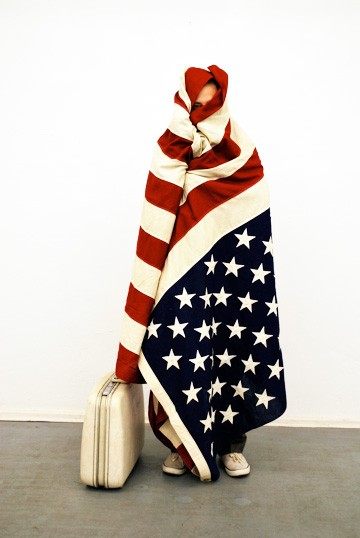
Not quite sure what to make of this, but this image showed up this morning on the golden livestreaming page for Man Bartlett’s piece, #140hBerlin.
And though maybe he wasn’t even born when it came out, it immediately made me think of… Sandra Bernhard’s 1990 performance film, Without You I’m Nothing
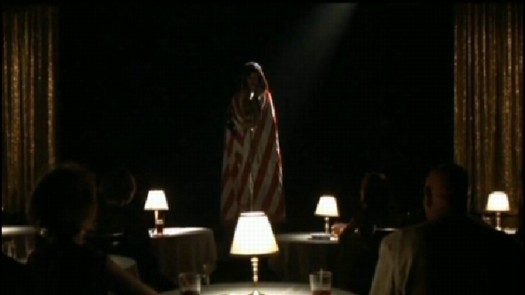
So yow, I just watched that clip on rutube.ru? Which, while it might offer Man some programming, if not costuming, ideas, also ties into Berlin’s own history.
And wow, I just listened to Bernhard’s cabaret cover of “Little Red Corvette” for the first time in maybe a decade, and damned if it isn’t one of the most American things about America this American has ever heard.
#140hBerlin runs for 140 hours through May 17. [manbartlett.com]
Leviathan Is Architecture
Believe me, I know how this looks.
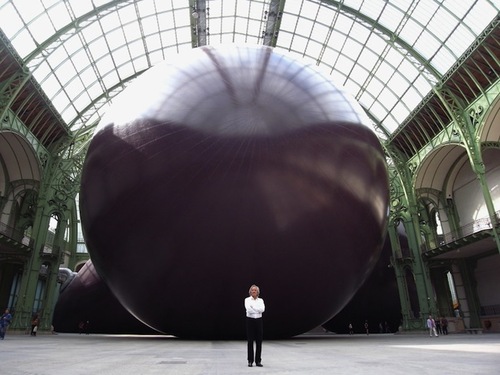
But also this. Balloons and the Grand Palais go way back:
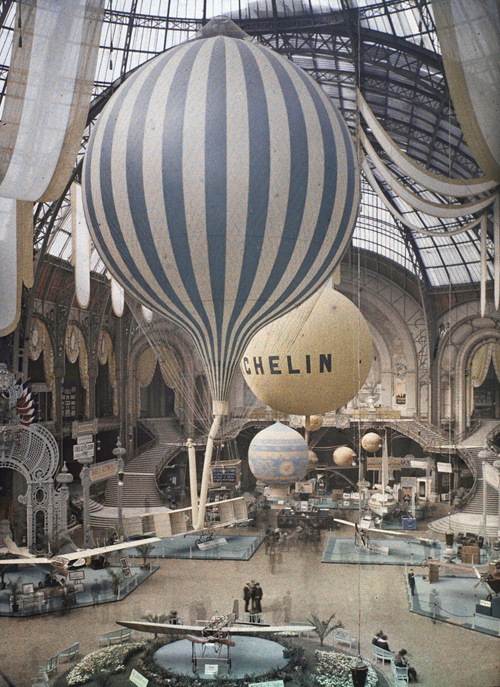
And anyway also this, Leviathan has a groin vault:
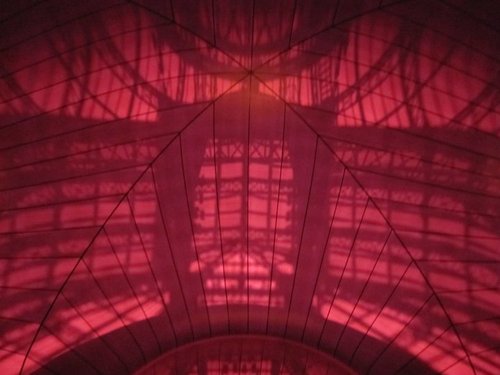
and is the venue for a concert performance by minimalist composer and maximalist stuffed animal shaman Charlemagne Palestine:
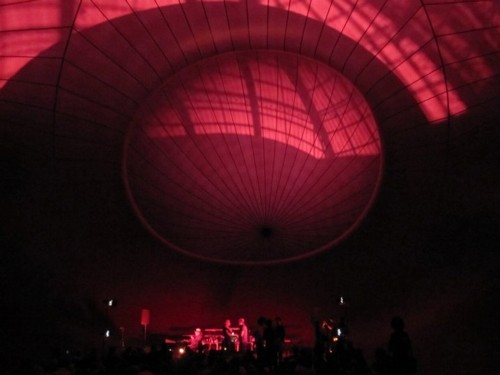
[image of Anish Kapoor posing in front of Leviathan via mymodernmet, as baited by starwarsmodern. Images of Charlemagne Palestine performance inside Leviathan via Monumenta 2011]
Sforzian, Deleuzian. Deleuzian, Sforzian.
“One idea could be using mirrors so photographers could do their jobs out of the president’s sight line, the White House’s Earnest said.”
My mind is blown and I am still picking up the pieces after contemplating the possibility that White House photographers might be instructed to shoot using mirrors so as not to disrupt the president’s line of sight.
I mean, the compositional challenges pale in comparison to the artistic compositional goldmine that such an environment would provide. I mean, just imagine. Here’s one AP shot I didn’t post the other day about Sforzian backdrops at Fort Campbell. Check out how the floating reflection of the camo netting draped over the crowd barrier, which is picked up in the teleprompter:

With mirrors, photos of the president would be like rainbows, visible only from the single specific angle that aligns the lens, the mirror, and the face.
Street photographers would suddenly have an edge. Lee Friedlander, traveling with the President:
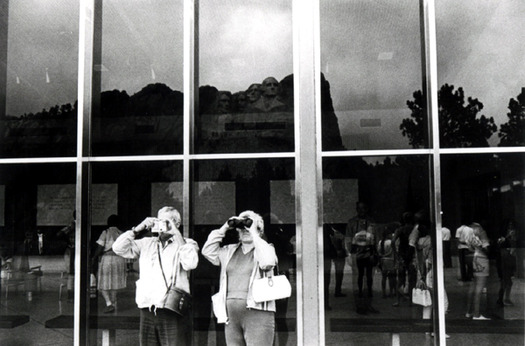
I’ve slowly been making my way through Kierran Horner’s analysis of Andrei Tarkovsky’s The Mirror in relation to Gilles Deleuze’s concept of the ‘time-image.’ I had just gotten to this part when I found the AP White House photo policy story:
Left alone, Alexei locates and sits in front of a large mirror hung on the wall. The next shot begins stationary behind Alexei, facing his reflection in the mirror, and the camera slowly pans in over his shoulder, focusing ever more tightly on his reflection, until, gradually, the reflection becomes the sole image of the frame, staring back toward the actual Alexei.
There is then a sharp cut to reveal a medium close-up of Alexei sat contemplating his reflection from the opposite angle. This shot/reverse shot dynamic and the ‘eye-line match’ are common to most conventional cinema, establishing an object, or person, as perceived by a character from their point of view.
As David Bordwell and Kristin Thompson describe it ‘shot A presents someone looking at something off-screen shot B shows us what is being looked at’ (2004: 303). However, as in this case, the ‘eye-line match’ refers conversely to an interaction between two characters, here, the actual Alexei and his virtual counterpart. It is as if he is reacting to/with his reflection. This dialectic can be read as representing the Deleuzian ‘crystal-image’:
‘In Bergsonian terms, the real object is reflected in a mirror-image as in the virtual object which, from its side and simultaneously, envelops or reflects the real: there is a ‘coalescence’ between the two. There is a formation of an image with two sides, actual and virtual. It is as if an image in a mirror, a photo or a postcard came to life, assumed independence and passed into the actual, even if this meant that the actual image returned into the mirror and resumed its place in the postcard or photo, following a double movement of liberation and capture.’ (Deleuze 2005b: 66-67)
I see Barack Obama as Alexei. And a virtual presidency. Can you begin to imagine what kinds of images this would produce? Forget the stunning conceptual aspects for a minute; has anyone at the White House thought through the political implications–should we call them the optics?–of not permitting the cameras’ eyes to gaze upon the President directly?
Maybe not mirrors, then, but what about one-way mirrors? Is that what they’re thinking? Put the photgraphers on the darkened side of a one-way mirror. Fortunately, there’s only 225 hours of Law & Order-related programming on basic cable each week to communicate the absolute trustworthiness of anyone speaking on the mirrored side of the glass.
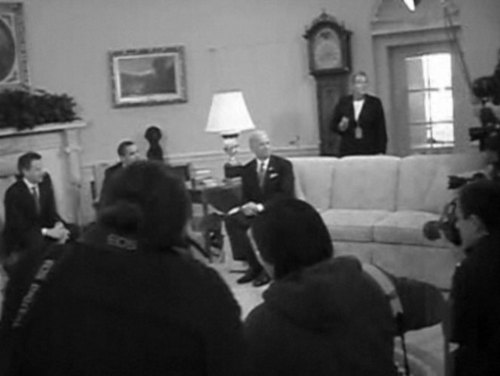
Before getting too fixated on the complications of presidential imagemaking, though, it’s worth remembering that the White House is already a supremely weird place for photographers to work. Go back to 2009, just days after President Obama’s inauguration, when the NY Times’ Stephen Crowley pulled back the curtain on the surreal and utterly staged 12-second tradition known as the “pool spray.” These are the images whose authenticity is suddenly, apparently, of such great concern.
Previously: WH beat photogs upset at staged photographs they don’t take
It’s All Done With Mirrors
So long, Sforzian Replays. After Reuters photographer Jason Reed went all meta about it on his blog last week, the White House has decided to do away with the longstanding practice of re-enacting speeches for reporters from different media.
“We have concluded that this arrangement is a bad idea,” Obama spokesman Josh Earnest said late Wednesday. He said the administration is open to working out some new arrangement with photographers.
…
There are conflicting accounts on whether technology exists to take photographs without distracting the president. One idea could be using mirrors so photographers could do their jobs out of the president’s sight line, the White House’s Earnest said.
Yes, by all means, mirrors. Pick mirrors, ohpleaseohpleaseohplease.
White House Announces End To Re-Enactments For News Photographers [ap/huffpo]
Point Break
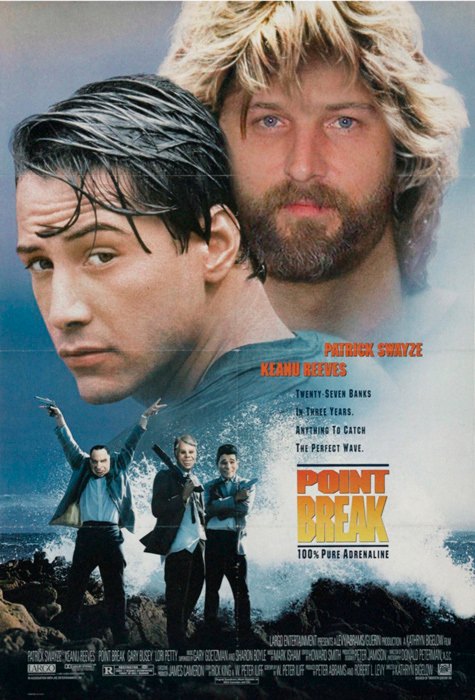
Untitled (Point Break), 2010, Roe Ethridge, via andrewkreps
This is in Le Luxe, Roe Ethridge’s awesome show at Kreps, through July 3rd.
Related: Crafting Genre: Kathryn Bigelow, a retrospective of the director’s film titles, combined with her early videos, paintings and conceptual artworks, opens at MoMA at the end of May. Point Break will be screening twice in early June, and once in August. [see the complete schedule.]
Nice

There sure has been a lot of calling card hoopla these days. It seems like it peaked just as I was moving an old file cabinet, and I found this packet of cards I had made in 1999 in Paris. They were still wrapped in the Hotel Costes stationery I’d used to break the order down and transport it more easily in my luggage.
I’d gotten them made at Calligrane, a small paper store in the Marais that still doesn’t have much of a web presence. I remember it as a little giftier than I like, with elaborate desk sets or something, but still the only place I could find who could do the typewriter-like letterpress cards I was seeking.

Because I did not want engraved cards, and I didn’t want fine paper. I already had business cards like that, and so did all kinds of people. What I needed, I told them, was a replica of the earlier calling cards I had made in 1995.
That’s when I had a business card with three addresses and six phone numbers in two countries on it, it was ugly and ridiculous. All I needed, I figured, was email [gallen@echonyc.com], and since it’s the internet, I really thought the cards should be typed.
I got really lucky, it turns out, because in Vieux Nice, just up the hill from the cathedral, was a little printing and paper studio run by a Scandinavian guy named Peter. He’d salvaged the type from old typewriters to do letterpress with. Wow, those were clean.
I still have one small box of those somewhere. It has Peter’s full name in a stamp on the bottom. I think when I looked him up to order replacements, he was still in Nice, but had switched from printing to sculpture. Gotta track that guy down again.
Photomural Collecting Not A Trend Yet
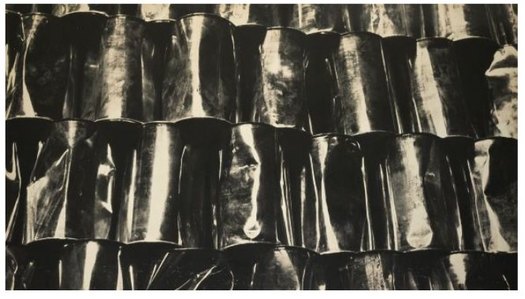
If my intermittent obsession with photomurals, and especially with the actual prints themselves, overlooked objects with a presence and character that feels now like a visual and experiential precursor to the monumental painting and photography of the contemporary era, has jumpstarted any interest in the market for these things, they haven’t heard about it in France.
On Monday, Artcurial included this 1964 “monumentale photographie” by Jean-Régis ROUSTAN, a 1.3 x 2.3 meter silver gelatin print of an abstracted wall of dented cans, in its books & manuscripts sale. But it failed to reach even its low low estimate.
LOT 483 Jean-Régis ROUSTAN Monumentale photographie, 1964 1,30 x 2,30 m, tirage argentique sur papier. Encadrement baquette aluminium. Nature morte de boites de conserves cabossées.
Estimation : 700 – 1000 €
Invendu
Tirage unique, offert à l’époque par l’artiste à l’actuel propriétaire. L’agrandissement monumental des boites entraine une abstraction. Légères taches.
Maybe it’s because Roustan was more photojournalist than artist? And though the lot before it went unsold, a set of six vintage prints of 1964 artist portraits by Roustan did sell for EUR829 last December. Duchamp, Calder, Ernst, Dali, Chagall…
But this is still a giant, beautiful, vintage object. I remain confused and convinced, if as-yet unmoved to schlep an 8-foot framed photo by a guy I confess, I hadn’t heard of until last week, over from Paris.
There’s No Escaping Leviathan
Hm, OK.
I think we’re in the clear here, satelloon-wise. It is true that Anish Kapoor’s Leviathan is inflated, and 35 meters tall.
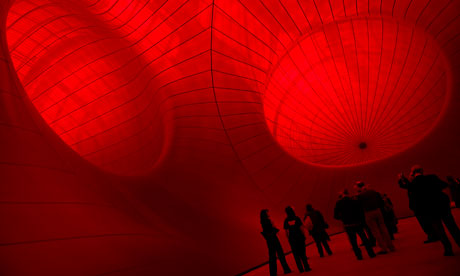
But when you enter the Grand Palais to see Leviathan, you enter Leviathan itself. It’s a space, a bulbous, three-chambered cathedral of a space, “like going into the belly of a whale,” says the Guardian. Though of course, it’s really going into the belly of a cinematic whale. So it’s a belly of imagination.
But it’s a space, not an object. At least, not at first. When you exit, though, it’s a thing. And well, hm. At first, things look pretty grim, which is to say, satelloonish.
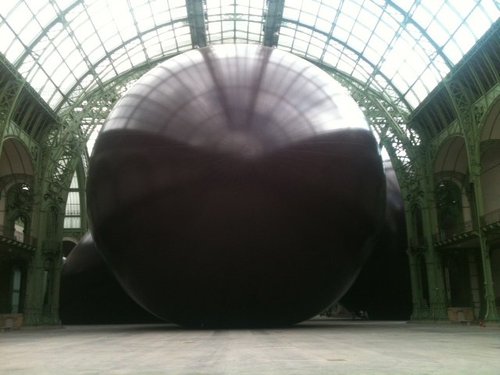
But ultimately, it’s a different thing, very different. One thing that’s emphasized in Kapoor’s talk to the Guardian is the light and space of the Grand Palais, and its vast expanses of glass:
“This is a terror of a space, probably much more difficult than the Turbine Hall,” Kapoor said. “It’s three times the size, huge horizontally and vertically and above all the light is a killer. It’s almost brighter than it is outside.”
There are any number of spaces–dirigible hangars, stadiums, train stations–that could hold a 100-ft mirror-skinned aluminum sphere; but in this time, there are no art spaces except, now, the Grand Palais. And that’s part of the point.
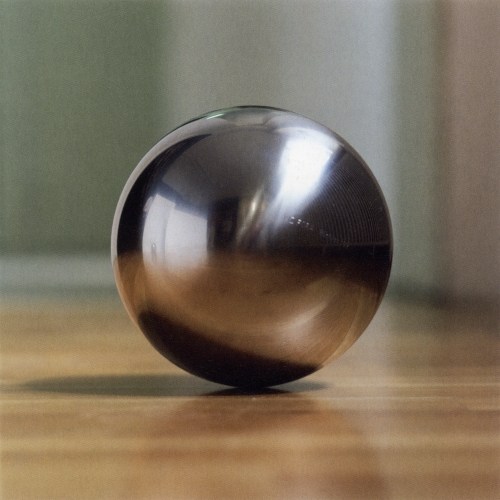
Not only can satelloons not escape the problems Gerhard Richter diagnosed for spheres–they’re too beautiful and perfect–they blow these problems up [sic] to gargantuan scale. Which is kind of interesting.
Monumenta 2011 has a Facebook wall [facebook.com]
MoMA WTF FTW
Alright, so I’m back from a day mostly spent at MoMA:
Wow, the Film Department is firing on all cylinders.
I remember one year when Chaka Khan yelled at the crowd for not paying enough attention to her, and now this year, Kanye West is performing to mad hype. Crazy.
Hmm, the fourth floor where I’d hoped to spend a great deal of time studing Jasper Johns’ Flag was “closed for reinstallation,” which means they’re part of the Missing Flag Coverup! Trust No One!
There are some Bridget Riley paintings in the hallway next to the cafe [I know] that look like they came from Bill Seitz’s 1965 Op Art blockbuster, The Responsive Eye. Don’t tell Larry Aldrich, though, or he’ll turn them into fabrics.
Really, a very crowded place.
Oh, I bought this anthology, Curating and the Educational Turn, and I think it’s going to be sweet. Unfortunately, with 27 different authors the chances of anyone topping this sentence, chosen at random from the introduction, are slim-to-none:
For several of the authors gathered here, these primarily function as points of departure for performative or polemical texts which themselves refuse a masterful discourse of explication in an attempt to honour the ethos of counter-institutional and counter-hegemonic practices of dissent and emergence.
Maybe curators have added pedagogical toolsets to their praxis because they’re fed up with people always asking them to explain what the hell they’re saying.
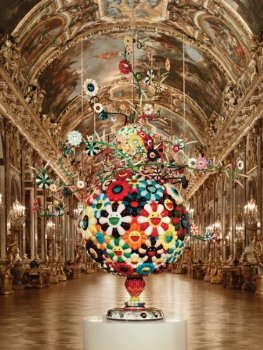
I almost bought what is undoubtedly the greatest book of its kind, Murakami Versailles, but it was too heavy to contemplate carrying it around. Also, I expect it will be entered into evidence in Murakami’s trail before the People’s Post-Revolutionary Court, so I can just grab a scaned version soon enough.

